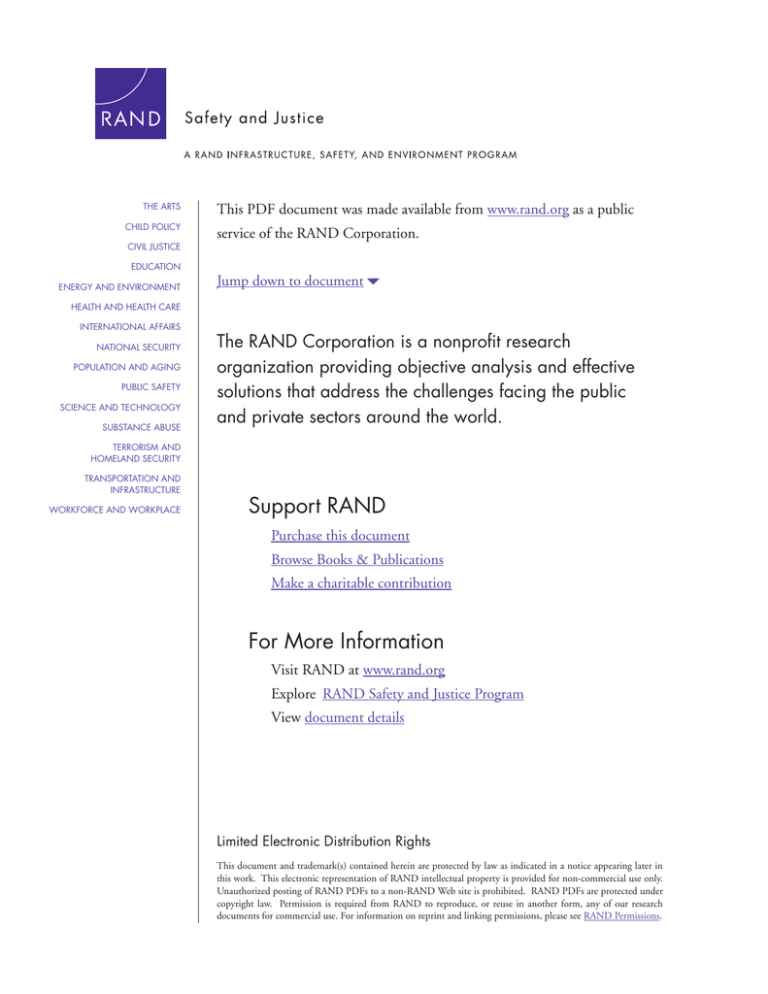
THE ARTS
CHILD POLICY
CIVIL JUSTICE
EDUCATION
ENERGY AND ENVIRONMENT
This PDF document was made available from www.rand.org as a public
service of the RAND Corporation.
Jump down to document6
HEALTH AND HEALTH CARE
INTERNATIONAL AFFAIRS
NATIONAL SECURITY
POPULATION AND AGING
PUBLIC SAFETY
SCIENCE AND TECHNOLOGY
SUBSTANCE ABUSE
The RAND Corporation is a nonprofit research
organization providing objective analysis and effective
solutions that address the challenges facing the public
and private sectors around the world.
TERRORISM AND
HOMELAND SECURITY
TRANSPORTATION AND
INFRASTRUCTURE
WORKFORCE AND WORKPLACE
Support RAND
Purchase this document
Browse Books & Publications
Make a charitable contribution
For More Information
Visit RAND at www.rand.org
Explore RAND Safety and Justice Program
View document details
Limited Electronic Distribution Rights
This document and trademark(s) contained herein are protected by law as indicated in a notice appearing later in
this work. This electronic representation of RAND intellectual property is provided for non-commercial use only.
Unauthorized posting of RAND PDFs to a non-RAND Web site is prohibited. RAND PDFs are protected under
copyright law. Permission is required from RAND to reproduce, or reuse in another form, any of our research
documents for commercial use. For information on reprint and linking permissions, please see RAND Permissions.
This product is part of the RAND Corporation technical report series. Reports may
include research findings on a specific topic that is limited in scope; present discussions of the methodology employed in research; provide literature reviews, survey
instruments, modeling exercises, guidelines for practitioners and research professionals, and supporting documentation; or deliver preliminary findings. All RAND
reports undergo rigorous peer review to ensure that they meet high standards for research quality and objectivity.
Los Angeles County
Juvenile Justice
Crime Prevention Act
Fiscal Year 2005–2006 Report
Susan Turner, Terry Fain, Amber Sehgal
with
Jitahadi Imara, Felicia Cotton of the Los Angeles
County Probation Department
Prepared for the Los Angeles County Probation Department
Safety and Justice
A RAND INFRASTRUCTURE, SAFETY, AND ENVIRONMENT PROGRAM
The research described in this report was conducted under the auspices of the Safety and
Justice Program within RAND Infrastructure, Safety, and Environment (ISE), a division of
the RAND Corporation, for the Los Angeles County Probation Department.
The RAND Corporation is a nonprofit research organization providing objective analysis
and effective solutions that address the challenges facing the public and private sectors
around the world. RAND’s publications do not necessarily reflect the opinions of its
research clients and sponsors.
R® is a registered trademark.
© Copyright 2007 RAND Corporation
All rights reserved. No part of this book may be reproduced in any form by any electronic or
mechanical means (including photocopying, recording, or information storage and retrieval)
without permission in writing from RAND.
Published 2007 by the RAND Corporation
1776 Main Street, P.O. Box 2138, Santa Monica, CA 90407-2138
1200 South Hayes Street, Arlington, VA 22202-5050
4570 Fifth Avenue, Suite 600, Pittsburgh, PA 15213-2665
RAND URL: http://www.rand.org/
To order RAND documents or to obtain additional information, contact
Distribution Services: Telephone: (310) 451-7002;
Fax: (310) 451-6915; Email: order@rand.org
- xv -
SUMMARY
THE JUVENILE JUSTICE CRIME PREVENTION ACT
In 2000, the California State Legislature passed the Schiff-Cardenas Crime
Prevention Act, which authorized funding for county juvenile justice programs and
designated the Board of Corrections (BOC) the administrator of funding. A 2001 Senate
Bill extended the funding and changed the program’s name to the Juvenile Justice Crime
Prevention Act. This effort was designed to provide a stable funding source for juvenile
programs that have been proven effective in curbing crime among at-risk and young
offenders.
JJCPA provided funds to counties to add evidence-based programs and services for
juvenile probationers identified with higher needs for special services than those received
by routine probationers, at-risk youths who have not yet entered the probation system but
who live or attend school in areas of high crime or who have other factors that potentially
predispose them to criminal activities, and youths in juvenile halls and camps. Each
juvenile is assigned to one or more JJCPA programs according to an assessment of the
individual’s need for services.
Administration of the JJCPA program is currently the responsibility of the
Corrections Standards Authority, formed in July 2005 by merging the BOC and the
Commission on Correctional Peace Officer Standards and Training (CPOST). The CSA
is required to submit annual reports to the California State Legislature measuring the
success of JJCPA. The legislation identified six specific outcome measures (the big six)
to be included in annual reports from each of the individual JJCPA programs. These
outcome measures are (1) successful completion of probation, (2) arrests, (3) probation
violations, (4) incarcerations, (5) successful completion of restitution, and (6) successful
completion of community service.1 Each county can also supply supplemental outcomes
to measure locally identified service needs.
1
For at-risk youths, i.e., those not on probation, only arrests and incarcerations are
reported herein, since the other four measures relate to conditions of probation.
- xvi -
JJCPA IN THE CONTEXT OF LOS ANGELES COUNTY PROBATION
DEPARTMENT PROGRAMS
JJCPA represents one of the major vehicles to provide services to juveniles.
JJCPA programs are administered by the Los Angeles County Probation Department,
whose mission is to promote and enhance public safety, ensure victims’ rights, and
facilitate the positive behavior change of adult and juvenile probationers. In FY05–06,
the state allocated more than $29 million to Los Angeles County for JJCPA programs and
services. This represents roughly one-third of juvenile field expenditures, one-quarter of
detention expenditures, and more than one-third of camp expenditures, or almost 10
percent of all juvenile expenditures.
JJCPA programs were designed to complement and leverage other probation
resources for at-risk and delinquent youths in the juvenile justice system. The leveraging
of resources allows the Deputy Probation Officer (DPO) to shape a plan that builds on the
strengths of each youth and is uniquely responsive to service needs. In collaboration with
school officials, parents, and community partners, JJCPA DPOs are able to coordinate
service plans that include various school- and community-based resources.
JJCPA programs are targeted toward juvenile probationers identified with higher
needs for special services than those received by routine probationers, as well as toward
at-risk youths, defined as those who are not on probation but who live or attend school in
areas of high crime or have other factors that potentially predispose them to criminal
activities. Each juvenile is assigned to one or more JJCPA programs according to an
assessment of the individual’s needs for service.
The Los Angeles County Probation Department submitted program evaluation
designs, approved by the BOC that used quasi-experimental methods. Programs included
a group of youths with characteristics similar to those of program youths where
appropriate, and a pre/post measurement design in instances where no appropriate
comparison group could be identified. Generally, outcomes for program participants are
measured for a six-month period after starting the program or after release into the
community (for camp and juvenile hall programs). In addition to the big six, the Los
Angeles County Probation Department, working with the BOC (and later with the CSA),
defined supplemental outcomes specific to each program, which are also reported to the
CSA annually.
Some discussion of the big six is in order. The CSA does not rank the relative
importance of these measures, nor is there any universally accepted relative importance
of these measures of recidivism. For its planning purposes, Los Angeles County has
- xvii -
ranked these in order, from most important to least important, in the view of Probation
Department standards: successful completion of probation, arrests, probation violations,
incarcerations, successful completion of restitution, and successful completion of
community service. An ideal outcome would be for no program youths to be arrested, be
incarcerated, or be in violation of probation and for all to complete probation as well as
(if applicable) community service and restitution. However, since for most JJCPA
programs the big six outcomes are measured only for six months after entry into the
program,2 and because most youths’ terms of probation last from 12 to 18 months, in
practice a 100 percent completion of probation rate is not a realistic expectation. For all
the big six measures, the most important metric is whether program youths performed
significantly better than comparison youths, not the absolute value of any given outcome.
We would also note that because program youths are more closely supervised than youths
on routine probation, it would not be surprising to find that they have more probation
violations than comparison youths.
PROGRAM CHANGES AND ENHANCEMENTS IN FY05–06
Using, in part, program outcome analyses from previous years, recommendations
from RAND, and stakeholder input, the Los Angeles County Probation Department made
several significant enhancements to JJCPA during FY04–05. In the first three years of
JJCPA in Los Angeles County, all JJCPA programs were organized into two initiatives
(Mental Health and School Success). In FY04–05, programs were realigned into three
initiatives—Enhanced Mental Health Services, Enhanced Services to High-Risk/HighNeed Youth, and Enhanced School- and Community-Based Services. Relatively few
additional changes were made in FY05–06, primarily the discontinuation of the
Community Treatment Facilities (CTF) program and the full implementation of the HighRisk/High-Needs (HRHN) program. These enhancements are detailed in Table S.1,
which compares JJCPA programs and initiatives from FY05–06 with those from FY01–
04.
2
For programs based in juvenile hall, the big six outcomes are measured for the six
months after the youth returns to the community, rather than from program start.
- xviii -
Table S.1
Programs in the Three JJCPA FY05–06 Initiatives
FY05–06 Initiative and Programs
I. Enhanced Mental Health Services
Mental Health Screening, Treatment, and Assessment (MH)
Multisystemic Therapy (MST)
II. Enhanced Services to High-Risk/High-Need Youth
Special Needs Court (SNC)
Youth Substance Abuse Intervention (YSA)
Gender-Specific Community (GSCOMM)
High-Risk/High Needs
III. Enhanced School and Community-Based Services
School-Based Probation Supervision (SBHS and SBMS)
Abolish Chronic Truancy (ACT)
After School Enrichment and Supervision (PARKS)
Housing-Based Day Supervision (HB)
Inside-Out Writers (IOW)
FY01–04 Initiative
Mental Health
Mental Health
Mental Health
School Success
School Success
N/A
School Success
School Success
School Success
School Success
School Success
Training Enhancements
Consistent with the implementation of evidence-based programs and the need to
strengthen the capacity of JJCPA community service providers, the Probation
Department continued training enhancements, begun in FY04–05, when it initiated
several training sessions for Probation staff and community-based partners. The focus of
this training was to strengthen service delivery through increased collaboration and case
management interventions. The training sessions included Los Angeles Risk and
Resiliency Checkup (LARRC), Strength-Based/Family-Focused Case Management Skills
training, and Social Learning Model (SLM) training.
Program Implementation and Enhancements
In response to program and contract monitoring reviews, family and participant
needs, and stakeholders’ feedback, the following JJCPA enhancements were
implemented, beginning in FY04–05 and continuing in FY05–06: (1) restructuring of the
Gang Intervention and Intensive Transition and Gender-Specific programs into the new
HRHN program; (2) implementation of family-based, rather than youth-based,
interventions; (3) parental skills training designed to empower parents ; (4)
implementation of School Safety Collaboratives/Safe Passages program for youths
traveling to and from school in high-crime areas as part of the school-based programs; (5)
increased emphasis on skill-building training and activities for JJCPA youths to provide
- xix -
anti-criminal modeling, social skills development, aggression replacement training skills,
problem-solving skills, and relapse prevention skills training; and (6) Correctional
Program Assessment Inventory (CPAI) training of contract monitoring staff to measure
how closely correctional programs meet known principles of effective intervention.
In addition, during this fiscal year, the Probation Department continued
strengthening program fidelity by administering LARRC to all probationers, and using
LARRC scores in program placement and offering social learning theory training for
JJCPA DPOs to help them align program practices with evidence-based theory.
OUTCOMES
CSA-mandated big six outcomes generally showed a similar pattern in FY05–06 as
in the previous fiscal year. JJCPA participants were more likely than comparison youths
to successfully complete probation, restitution, and community service. For programs
that used a contemporaneous comparison group (SNC, MST, School-Based High School
and Middle School Probation Supervision for Probationers [SBHS-PROB and SBMSPROB, respectively]), as well as those evaluated using a pre/post design (ACT, YSA,
PARKS, GSCOMM, HB, and IOW), JJCPA youths tended to show fewer arrests and
fewer incarcerations. Because juvenile arrest rates in Los Angeles County were higher
for juveniles in FY05–06 than in any year since 1996, JJCPA programs that used a
historical comparison group (MH, School-Based High School and Middle School
Probation Supervision for At-Risk Youths [SBHS-AR and SBMS-AR, respectively], and
HRHN) did not generally show lower arrest or incarceration rates than comparison
youths.
Supplemental outcomes, which varied from program to program, were generally
more positive in the reference period after starting the program than in the comparable
period before beginning the program. School attendance, in particular, improved
markedly for those programs that used attendance as a supplemental outcome measure.
For these programs, school suspensions and expulsions were likely to decrease as well.
Programs whose supplemental outcomes were not school-related also tended to show
positive results in the measures used.
PROGRAMS AND OUTCOMES IN INITIATIVE I: ENHANCED MENTAL
HEALTH SERVICES
Before JJCPA, the Los Angeles County Probation Department processed juvenile
referrals in a manner similar to most probation departments in California, offering crisis
- xx -
intervention services only. There was no dedicated court to address youths with severe
mental health issues, few if any placement options for crossover populations, and no costeffective family-based community treatment service. These problems were addressed in
FY05–06 by two programs within the mental health services initiative: MH and MST.
SUMMARY OF OUTCOMES FOR THE ENHANCED MENTAL HEALTH
SERVICES INITIATIVE
Because youths in the MH program represent more than 99 percent of all youths in
the Enhanced Mental Health Services initiative, the results for the initiative as a whole
will necessarily be virtually identical to those for the MH program. JJCPA youths in the
Enhanced Mental Health Services initiative showed higher completion of community
service rates than youths in the comparison groups. However, program youths had higher
arrest and incarceration rates than comparison youths, more probation violations, and
lower completion of restitution rates and completion of probation rates. This may be due,
at least in part, to the use of a historical comparison group from a time when juvenile
arrest rates were lower than in FY05–06. Supplemental outcomes for both MH and MST
were significantly improved in the six months after program entry compared with the six
months before entering the program.
PROGRAMS AND OUTCOMES IN INITIATIVE II: ENHANCED SERVICES TO
HIGH-RISK/HIGH-NEED YOUTH
The High-Risk/High-Need initiative targets youth at the highest risk and those with
the highest need in the JJCPA program. Programs and services in this initiative include
SNC, YSA, GSCOMM,3 and the new HRHN program. Many of the youths participating
in this initiative are gang involved, drug and alcohol users, and low academic performers;
have mental health issues and multiple risk/needs factors across multiple domains; and
pose a high risk for committing new crimes. Therefore, consistent with juvenile justice
research, the initiative targets higher-risk offenders and criminogenic risk/need factors,
considers responsivity factors, and employs social learning approaches.
3
Gender-specific community programs include the Young Women at Risk
(YWAR) program.
- xxi -
SUMMARY OF OUTCOMES FOR THE ENHANCED SERVICES TO HIGHRISK/HIGH-NEED YOUTH INITIATIVE
Overall, program youths in the Enhanced Services to High-Risk/High-Need Youth
initiative had higher rates for completion of probation and community service than
comparison group youths. Program youths also had lower rates of arrests, incarcerations,
and completion of restitution than comparison youths, but these differences were not
statistically significant. Program youths did, however, also have significantly higher
probation violation rates than comparison group youths. Higher rates of probation
violation may result, at least in part, because program youths are more closely monitored
than are routine probationers. The relevant supplemental outcomes for SNC, GSCOMM,
and HRHN participants were significantly improved in the six months after entering the
program compared with the six months before entering.
PROGRAMS AND OUTCOMES IN INITIATIVE III: ENHANCED SCHOOLAND COMMUNITY-BASED SERVICES
The school-based program is at the core of this initiative and has as its main
objective the reduction of crime and delinquency in 85 high-risk neighborhoods by
targeting school-based probation supervision and services for the population of
probationers and at-risk youths in the schools. A secondary goal is enhanced protective
factors through improved school performance. The 85 targeted neighborhoods were
identified as the most crime-affected neighborhoods in Los Angeles County on the basis
of number of youths on probation at the schools, rate of overall crime, rate of juvenile
crime, rate of substance abuse, rate of child abuse and neglect, and number of residents
below the poverty level.
Programs and services included in this initiative are SBHS-PROB, SBMS-PROB,
SBHS-AR, SBMS-AR, ACT, PARKS, HB, and IOW. A total of 13,659 youths received
services from programs in the school-based initiative during the JJCPA program’s FY05–
06.
SUMMARY OF OUTCOMES FOR THE ENHANCED SCHOOL- AND
COMMUNITY-BASED SERVICES INITIATIVE
Taken as a whole, youths in the Enhanced School- and Community-Based Services
initiative showed improvements in the completion of restitution, as well as a lower rate of
incarceration in the follow-up period, as compared to the baseline period or comparison
group. Because so few youths in this initiative completed probation or community
service during the baseline period, differences seen in the follow-up (overall 13.3 percent
- xxii -
completed probation and 13.2 percent completed community service) were not
statistically testable. Although arrest rates were lower in the follow-up period than in the
baseline, the differences were not statistically significant. For the programs that used
educational measures as supplemental outcomes, school attendance improved
significantly in the term following program entry as compared with the previous term,
and there were significant reductions in school suspensions and expulsions. All other
supplemental outcomes showed significant improvement except for the PARKS program,
where a single arrest occurred between 3:00 p.m. and 6:00 p.m. during both the baseline
and follow-up periods.
JJCPA PER CAPITA COSTS
A total of 29,116 youths were served in JJCPA in FY05–06, at a total cost of
$29,334,436, or $1,008 per participant.4 As one might expect, some programs had lower
per capita costs than others. In general, the larger programs, such as MH, had the lowest
per capita costs, whereas the programs that offered more extensive services to a smaller
population, such as SNC, had higher per capita costs. Table S.2 shows the total budget
for each program, the number of youths served in FY05–06, and the cost per program
participant. Overall, the cost per youth in the Enhanced Mental Health Services initiative
in FY05–06 was $490, whereas the Enhanced Services to High-Risk/High-Need Youth
initiative cost $4,147 per youth served, and the Enhanced School- and Community-Based
Services programs spent $1,070 per youth.
4
The number of youths served in FY05–06 is greater than the number of youths for
whom outcome measures were reported to the CSA, because the time frames are
different. Because our cost estimates include arrests during the six-month eligibility
mandated for big six outcomes, the number of program youths will match the number
used to report outcomes to the CSA, not the total number served during the fiscal year.
- xxiii -
Table S.2
Per Capita Costs, by JJCPA Program: FY05–06
Initiative/Program
MH
MST
Enhanced Mental Health Services
initiative
SNC
YSA
YWAR/GSCOMM
HRHN
Enhanced Services to HighRisk/High-Need Youth initiative
SBHS
SBMS
ACT
PARKS
HB
IOW
Enhanced School- and
Community-Based Services
initiative
All programs
Youths Served
13,412
91
Budget
$6,134,459
$478,297
Per Capita
$457
$5,256
13,503
$6,612,756
$490
98
139
604
1,113
$1,162,702
$1,162,702
$1,684,967
$4,093,378
$11,864
$8,365
$2,790
$3,678
1,954
$8,103,749
$4,147
6,585
1,246
3,530
975
288
1,035
$8,746,799
$1,543,554
$303,204
$1,700,144
$1,933,106
$391,124
$1,328
$1,239
$86
$1,744
$6,712
$378
13,659
29,116
$14,617,931
$29,334,436
$1,070
$1,008
Components of Cost
In addition to the costs of delivering JJCPA services in the various programs, other
costs are also incurred by JJCPA participants. These include the costs of supervision for
those on probation, of juvenile hall for those who spend time in the halls, of juvenile
camp for those assigned to camp, of receiving a technical violation of probation, and the
various costs associated with being arrested and going to court. We have also included,
as a “negative” cost, the benefits of increased school attendance for youths in the schoolbased programs. In our analysis of overall JJCPA costs, we have attempted to estimate
each on a daily basis to calculate the actual cost of each individual participant.
It should be emphasized that these are estimated costs, based on the best
information available at the time of this report. Most involve calculations involving
estimates provided by the Probation Department or from publicly available data. These
analyses are not intended to provide exact costs but to give an indication of approximate
trends for each program and to allow comparisons between program participants in the
six months after entering JJCPA programs versus the six months before entering.
- xxiv -
Total Cost of Programs and Initiatives
Table S.3 shows the mean total cost per participant in JJCPA programs in FY05–
06. Weighted averages are also shown for each initiative. It should be noted that the
costs for each initiative are largely driven by the costs of the program or programs in that
initiative that serve the most participants. Thus MST costs have very little influence on
the overall costs of the Enhanced Mental Health Services initiative, since the vast
majority of youths served within that initiative are in the MH program.
Table S.3
Mean Total Cost per Participant by JJCPA Program: FY05–06
Initiative/Program
MH
MST
Enhanced Mental Health
Services initiative
SNC
YSA
YWAR and GSCOMM
HRHN
Enhanced Services to HighRisk/High-Need Youth
initiative
SBHS-PROB
SBHS-AR
SBMS-PROB
SBMS-AR
ACT
PARKS
HB
IOW
Enhanced School- and
Community-Based Services
initiative
All programs
Baseline
$8,194
$4,622
Follow–Up
$13,859
$11,258
Participants
10,474
63
$8,173
$13,843
10,537
$19,161
$3,926
$1,054
$11,596
$24,141
$10,981
$4,262
$10,116
60
197
409
496
$6,976
$8,926
1,162
$5,148
$64
$4,473
$34
$3
$85
$1,741
$11,564
$4,619
$1,550
$4,576
$753
$75
$1,661
$6,056
$14,015
3,897
326
239
481
2,273
843
168
520
$3,150
$3,411
8,747
$5,956
$9,101
20,446
As we might expect, overall juvenile justice costs for JJCPA participants were
generally higher in the follow-up period ($9,101) than in the baseline period ($5,956),
primarily because six months is not a long enough time to evaluate the long-term benefits
of changes brought about by participating in JJCPA programs. The majority of the
- xxv -
JJCPA programs, however, produced substantial average costs savings in arrests, hall,
court, and camp costs. If these costs savings were accumulated over a longer period of
time they may offset the substantial investment made in program costs. We are not able
to extend the time frame to measure changes, however, because not enough time has
elapsed to allow us to obtain data beyond a six-month period. With a longer follow-up
period, the initial program costs may be offset by reductions in subsequent arrests, court
appearances, and days spent in halls and camps.
We note also that savings in juvenile justice costs for arrests, camps, and juvenile
halls do not take into account potential savings associated with improved family and
community relations. Because we have no data on the value of such improvements, we
are not able to include these factors in our estimates of cost differences between the
baseline and follow-up periods.
It is actually somewhat surprising to note that participants in the Enhanced Schooland Community-Based Services initiative had only slightly higher total juvenile justice
costs in the follow-up period than in the baseline period. This finding is driven primarily
by cost savings among school-based high school probationers and the low costs of
programs targeting at-risk youths.
Component Cost Savings by Initiative
For each of the three FY05–06 initiatives, Table S.4 shows the mean net cost for
each cost component, i.e., the mean difference between the cost in the six months before
entering the program and the six months after entering. As we might expect, there are
noticeable differences in mean component costs among the three initiatives. The
Enhanced Mental Health Services initiative, which serves only probationers, showed
fewer arrest costs, but much higher camp costs after entering the program than before
entering. The Enhanced Services to High-Risk/High-Need Youth initiative, which targets
a large number of at-risk youths, saw the bulk of its expenses in program costs, whereas
costs for arrests, juvenile hall, camp, and court were lower in the six months after
entering the program. The Enhanced School- and Community-Based Services initiative,
which targets a combination of probationers and at-risk youths, saw increased program
and supervision costs but savings in arrest and court costs after entering the program.
- xxvi -
Table S.4
Mean Cost Savings for Initiatives: FY05–06
Enhanced Services Enhanced SchoolEnhanced Mental
to High-Risk/
and CommunityComponent
Health Services
High-Need Youth
Based Services
Program
–$429
–$4,362
–$870
Supervision
–$308
–$35
–$323
Arrest
$889
$79
$236
Juvenile hall
–$952
$383
–$59
Camp
–$4,418
$2,038
–$20
Court
–$453
$190
$541
Total
–$5,671
–$1,703
–$261
NOTES: A positive number in this table indicates that mean costs were lower
in the six months after beginning the program than in the six months before
beginning. A negative number indicates that costs were higher after entering the
program than before entering. Total costs may include “negative costs” of
improved school attendance. Because of missing data for some components, total
cost may not equal the sum of the component costs.
In general, higher rates of recidivism seem to occur in the more expensive JJCPA
programs. This may be because these programs target higher-risk youths than do the
less-expensive programs.
LIMITATIONS OF THIS EVALUATION
As with any evaluation, there are inherent limitations in our assessment of the
JJCPA program in Los Angeles County. As we have noted, no randomized designs were
used and we were unable to verify the comparability of comparison groups for some of
the programs, so that observed differences between treatment and comparison groups
may reflect pretreatment differences between the groups rather than treatment effects of
the programs. Another limitation is the ability to follow program participants for only six
months.
This is the fifth year of RAND’s JJCPA evaluation findings. Over the years, the
strength and breadth of the evaluation has improved. More-rigorous comparison groups
have been identified for some programs, and the overall quality of outcome data has
continued to improve. This is the second year we have added cost comparisons to our
report. Work by the Probation Department to enhance and improve the quality of
program delivery continues through continued concentration on social learning, family
- xxvii -
orientation, and auditing the implementation of programs using the principles of the
CPAI.
CONCLUSIONS
This is the fifth consecutive year that outcomes were reported to CSA and to the
county. Results reflect the continuing collaboration between the evaluators and Probation
to modify programs based on evaluation findings. We still see that the effects sizes are
relatively small, although county-developed supplemental outcomes tend to be more
favorable than state-mandated big six outcomes. Los Angeles County will continue to
receive JJCPA funding on an annual basis and will continue to report outcomes to CSA
annually.





